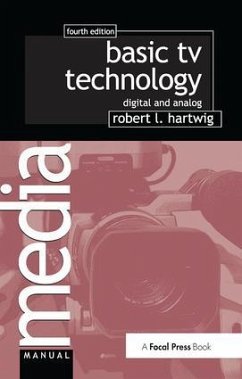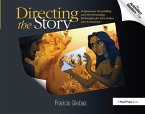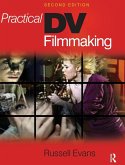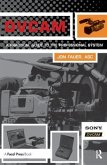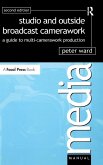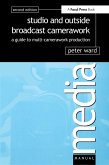- Gebundenes Buch
- Merkliste
- Auf die Merkliste
- Bewerten Bewerten
- Teilen
- Produkt teilen
- Produkterinnerung
- Produkterinnerung
A guide to the fundamentals underlying television and video systems, it provides an explanation of how the principal pieces of equipment work, what their functions are, and how they are integrated to form a complex video system. It also includes information on compression, television standards, LCD displays, HD, and equipment.
Andere Kunden interessierten sich auch für
![Fix It in Post Fix It in Post]() Jack JamesFix It in Post199,99 €
Jack JamesFix It in Post199,99 €![Directing the Story Directing the Story]() Francis GlebasDirecting the Story189,99 €
Francis GlebasDirecting the Story189,99 €![Practical DV Filmmaking Practical DV Filmmaking]() Russell EvansPractical DV Filmmaking197,99 €
Russell EvansPractical DV Filmmaking197,99 €![Dvcam Dvcam]() Asc FauerDvcam197,99 €
Asc FauerDvcam197,99 €![Stand-Out Shorts Stand-Out Shorts]() Russell EvansStand-Out Shorts197,99 €
Russell EvansStand-Out Shorts197,99 €![Studio and Outside Broadcast Camerawork Studio and Outside Broadcast Camerawork]() Peter WardStudio and Outside Broadcast Camerawork198,99 €
Peter WardStudio and Outside Broadcast Camerawork198,99 €![Studio and Outside Broadcast Camerawork Studio and Outside Broadcast Camerawork]() Peter WardStudio and Outside Broadcast Camerawork73,99 €
Peter WardStudio and Outside Broadcast Camerawork73,99 €-
-
-
A guide to the fundamentals underlying television and video systems, it provides an explanation of how the principal pieces of equipment work, what their functions are, and how they are integrated to form a complex video system. It also includes information on compression, television standards, LCD displays, HD, and equipment.
Hinweis: Dieser Artikel kann nur an eine deutsche Lieferadresse ausgeliefert werden.
Hinweis: Dieser Artikel kann nur an eine deutsche Lieferadresse ausgeliefert werden.
Produktdetails
- Produktdetails
- Verlag: Taylor & Francis
- 4th edition
- Seitenzahl: 204
- Erscheinungstermin: 11. Juli 2017
- Englisch
- Gewicht: 453g
- ISBN-13: 9781138426061
- ISBN-10: 1138426067
- Artikelnr.: 48950084
- Herstellerkennzeichnung
- Libri GmbH
- Europaallee 1
- 36244 Bad Hersfeld
- gpsr@libri.de
- Verlag: Taylor & Francis
- 4th edition
- Seitenzahl: 204
- Erscheinungstermin: 11. Juli 2017
- Englisch
- Gewicht: 453g
- ISBN-13: 9781138426061
- ISBN-10: 1138426067
- Artikelnr.: 48950084
- Herstellerkennzeichnung
- Libri GmbH
- Europaallee 1
- 36244 Bad Hersfeld
- gpsr@libri.de
Robert Lee Hartwig was born and raised in a small northern California farming town. At the age of 13, his parents bought an 8mm movie camera. He spent the next couple of years fooling around with animation and teaching himself simple film editing. He spent his teenage summers on the family farm. He attended Chico State University where, quite by accident, he got involved in the college radio station. While involved in college radio, he served as Business Manager of the station and was appointed to be the student manager of the station. At the same time, the school was developing a Mass Communications Degree program, which he transferred to as soon as the program opened. While in school, he worked at both AM and FM radio stations as an on-air announcer. He still worked summers on the farm because the 80 - 100 hour weeks made a lot more money for him. He was a member of the first graduating class in Mass Communications from Chico State where the faculty awarded him the Leadership Merit Award upon graduation. He went to San Diego State University for his Master's Degree in Radio and Television. Coming from a rural background, living in a city the size of San Diego drove him nuts. The culture shock was the greatest challenge to completing the MA. While working on the MA, he also worked for the San Diego Area Instructional Television Authority, was a Television Specialist for the Adult Division of the San Diego Community College District, worked as a photographer on a special project for the San Diego Community College Association, and taught a night class in TV Production for the Adult Division of the San Diego Community College District. This teaching experience gave him the teaching bug. He was granted his MA in December of 1973. He moved back to northern California and got a part-time teaching job in the Mass Communications Department at Butte Community College in Oroville, CA. While at Butte he also produced and directed video programs for t
The Atom & Electricity
Basic Circuits
Units of Measurement
Fields (Induction) and Noise
Abbreviations
Cathode Ray Tubes (CRTs)
Need for interlace scanning
Blanking
Waveform Display
Charge Coupled Devices
An Introduction to Digital
Analog and Digital
Color System
How the Eye Sees Light
Digital Encoding Ratios
CODECs
Composite Encoding
Color CRTs
Plasma Display Screens
LCD Screens
Analog Sync Generators
Vectorscope
PAL
Combining Sync and Camera Flow Diagrams
Video Switchers
Switcher Applications
Production Switcher Flow Diagram
Switcher Transitions and Special Effects
Special Effects Keys--Luminance Keys, Chroma Keys
Composite Versus Component Video
Color Difference Component Video
Digital Special Effects
Digital Interpolation
Analog Videotape Recording Technology
Analog Video Recording Standards & Formats
Other Tracks and Lockup
Time Base Error and Correction
Larger Analog Sync Problems & Solutions
Other Advantages of TBCs & Frame Synchronizers
Digital Videotape Recorders
Digital Video Servers
Disc Based Recorders
Editing Analog Videotape
The Editing Process
Types of Edits
Editing Methods-Manual editing and Control track counters
SMPTE Time Code Editing
Off/On Line Editing
Editing by Computers
Problems of Traditional Editing
Non Linear Editing
Video, Spatial, Temporal Compression
MPEG Compression Standard
Computer Graphics for Video
Character Generators
Creating Imagery & Effects
The Digital Studio
Open Architecture vs. Dedicated Equipment
Drawbacks of Open Architecture Equipment
HD TV
ATSC HD Broadcast Standard
SDTV
Audio for Video
Surround Sound
Professional and Consumer Audio
Combining Audio Components
Microphones, Mixers, and Loudspeakers
Sound Recording for Video
Digital Audio Workstations
Further Reading
Glossary
Basic Circuits
Units of Measurement
Fields (Induction) and Noise
Abbreviations
Cathode Ray Tubes (CRTs)
Need for interlace scanning
Blanking
Waveform Display
Charge Coupled Devices
An Introduction to Digital
Analog and Digital
Color System
How the Eye Sees Light
Digital Encoding Ratios
CODECs
Composite Encoding
Color CRTs
Plasma Display Screens
LCD Screens
Analog Sync Generators
Vectorscope
PAL
Combining Sync and Camera Flow Diagrams
Video Switchers
Switcher Applications
Production Switcher Flow Diagram
Switcher Transitions and Special Effects
Special Effects Keys--Luminance Keys, Chroma Keys
Composite Versus Component Video
Color Difference Component Video
Digital Special Effects
Digital Interpolation
Analog Videotape Recording Technology
Analog Video Recording Standards & Formats
Other Tracks and Lockup
Time Base Error and Correction
Larger Analog Sync Problems & Solutions
Other Advantages of TBCs & Frame Synchronizers
Digital Videotape Recorders
Digital Video Servers
Disc Based Recorders
Editing Analog Videotape
The Editing Process
Types of Edits
Editing Methods-Manual editing and Control track counters
SMPTE Time Code Editing
Off/On Line Editing
Editing by Computers
Problems of Traditional Editing
Non Linear Editing
Video, Spatial, Temporal Compression
MPEG Compression Standard
Computer Graphics for Video
Character Generators
Creating Imagery & Effects
The Digital Studio
Open Architecture vs. Dedicated Equipment
Drawbacks of Open Architecture Equipment
HD TV
ATSC HD Broadcast Standard
SDTV
Audio for Video
Surround Sound
Professional and Consumer Audio
Combining Audio Components
Microphones, Mixers, and Loudspeakers
Sound Recording for Video
Digital Audio Workstations
Further Reading
Glossary
The Atom & Electricity; Basic Circuits; Units of Measurement; Fields (Induction) and Noise; Abbreviations; Cathode Ray Tubes (CRTs); Need for interlace scanning; Blanking; Waveform Display; Charge Coupled Devices; An Introduction to Digital; Analog and Digital; Color System; How the Eye Sees Light; Digital Encoding Ratios; CODECs; Composite Encoding; Color CRTs; Plasma Display Screens; LCD Screens; Analog Sync Generators; Vectorscope; PAL; Combining Sync and Camera Flow Diagrams; Video Switchers; Switcher Applications; Production Switcher Flow Diagram; Switcher Transitions and Special Effects; Special Effects Keys--Luminance Keys, Chroma Keys; Composite Versus Component Video; Color Difference Component Video; Digital Special Effects; Digital Interpolation; Analog Videotape Recording Technology; Analog Video Recording Standards & Formats; Other Tracks and Lockup; Time Base Error and Correction; Larger Analog Sync Problems & Solutions; Other Advantages of TBCs & Frame Synchronizers; Digital Videotape Recorders; Digital Video Servers; Disc Based Recorders; Editing Analog Videotape; The Editing Process; Types of Edits; Editing Methods-Manual editing and Control track counters; SMPTE Time Code Editing; Off/On Line Editing; Editing by Computers; Problems of Traditional Editing; Non Linear Editing; Video, Spatial, Temporal Compression; MPEG Compression Standard; Computer Graphics for Video; Character Generators; Creating Imagery & Effects; The Digital Studio; Open Architecture vs. Dedicated Equipment; Drawbacks of Open Architecture Equipment; HD TV; ATSC HD Broadcast Standard; SDTV; Audio for Video; Surround Sound; Professional and Consumer Audio; Combining Audio Components; Microphones, Mixers, and Loudspeakers; Sound Recording for Video; Digital Audio Workstations; Further Reading; Glossary
The Atom & Electricity
Basic Circuits
Units of Measurement
Fields (Induction) and Noise
Abbreviations
Cathode Ray Tubes (CRTs)
Need for interlace scanning
Blanking
Waveform Display
Charge Coupled Devices
An Introduction to Digital
Analog and Digital
Color System
How the Eye Sees Light
Digital Encoding Ratios
CODECs
Composite Encoding
Color CRTs
Plasma Display Screens
LCD Screens
Analog Sync Generators
Vectorscope
PAL
Combining Sync and Camera Flow Diagrams
Video Switchers
Switcher Applications
Production Switcher Flow Diagram
Switcher Transitions and Special Effects
Special Effects Keys--Luminance Keys, Chroma Keys
Composite Versus Component Video
Color Difference Component Video
Digital Special Effects
Digital Interpolation
Analog Videotape Recording Technology
Analog Video Recording Standards & Formats
Other Tracks and Lockup
Time Base Error and Correction
Larger Analog Sync Problems & Solutions
Other Advantages of TBCs & Frame Synchronizers
Digital Videotape Recorders
Digital Video Servers
Disc Based Recorders
Editing Analog Videotape
The Editing Process
Types of Edits
Editing Methods-Manual editing and Control track counters
SMPTE Time Code Editing
Off/On Line Editing
Editing by Computers
Problems of Traditional Editing
Non Linear Editing
Video, Spatial, Temporal Compression
MPEG Compression Standard
Computer Graphics for Video
Character Generators
Creating Imagery & Effects
The Digital Studio
Open Architecture vs. Dedicated Equipment
Drawbacks of Open Architecture Equipment
HD TV
ATSC HD Broadcast Standard
SDTV
Audio for Video
Surround Sound
Professional and Consumer Audio
Combining Audio Components
Microphones, Mixers, and Loudspeakers
Sound Recording for Video
Digital Audio Workstations
Further Reading
Glossary
Basic Circuits
Units of Measurement
Fields (Induction) and Noise
Abbreviations
Cathode Ray Tubes (CRTs)
Need for interlace scanning
Blanking
Waveform Display
Charge Coupled Devices
An Introduction to Digital
Analog and Digital
Color System
How the Eye Sees Light
Digital Encoding Ratios
CODECs
Composite Encoding
Color CRTs
Plasma Display Screens
LCD Screens
Analog Sync Generators
Vectorscope
PAL
Combining Sync and Camera Flow Diagrams
Video Switchers
Switcher Applications
Production Switcher Flow Diagram
Switcher Transitions and Special Effects
Special Effects Keys--Luminance Keys, Chroma Keys
Composite Versus Component Video
Color Difference Component Video
Digital Special Effects
Digital Interpolation
Analog Videotape Recording Technology
Analog Video Recording Standards & Formats
Other Tracks and Lockup
Time Base Error and Correction
Larger Analog Sync Problems & Solutions
Other Advantages of TBCs & Frame Synchronizers
Digital Videotape Recorders
Digital Video Servers
Disc Based Recorders
Editing Analog Videotape
The Editing Process
Types of Edits
Editing Methods-Manual editing and Control track counters
SMPTE Time Code Editing
Off/On Line Editing
Editing by Computers
Problems of Traditional Editing
Non Linear Editing
Video, Spatial, Temporal Compression
MPEG Compression Standard
Computer Graphics for Video
Character Generators
Creating Imagery & Effects
The Digital Studio
Open Architecture vs. Dedicated Equipment
Drawbacks of Open Architecture Equipment
HD TV
ATSC HD Broadcast Standard
SDTV
Audio for Video
Surround Sound
Professional and Consumer Audio
Combining Audio Components
Microphones, Mixers, and Loudspeakers
Sound Recording for Video
Digital Audio Workstations
Further Reading
Glossary
The Atom & Electricity; Basic Circuits; Units of Measurement; Fields (Induction) and Noise; Abbreviations; Cathode Ray Tubes (CRTs); Need for interlace scanning; Blanking; Waveform Display; Charge Coupled Devices; An Introduction to Digital; Analog and Digital; Color System; How the Eye Sees Light; Digital Encoding Ratios; CODECs; Composite Encoding; Color CRTs; Plasma Display Screens; LCD Screens; Analog Sync Generators; Vectorscope; PAL; Combining Sync and Camera Flow Diagrams; Video Switchers; Switcher Applications; Production Switcher Flow Diagram; Switcher Transitions and Special Effects; Special Effects Keys--Luminance Keys, Chroma Keys; Composite Versus Component Video; Color Difference Component Video; Digital Special Effects; Digital Interpolation; Analog Videotape Recording Technology; Analog Video Recording Standards & Formats; Other Tracks and Lockup; Time Base Error and Correction; Larger Analog Sync Problems & Solutions; Other Advantages of TBCs & Frame Synchronizers; Digital Videotape Recorders; Digital Video Servers; Disc Based Recorders; Editing Analog Videotape; The Editing Process; Types of Edits; Editing Methods-Manual editing and Control track counters; SMPTE Time Code Editing; Off/On Line Editing; Editing by Computers; Problems of Traditional Editing; Non Linear Editing; Video, Spatial, Temporal Compression; MPEG Compression Standard; Computer Graphics for Video; Character Generators; Creating Imagery & Effects; The Digital Studio; Open Architecture vs. Dedicated Equipment; Drawbacks of Open Architecture Equipment; HD TV; ATSC HD Broadcast Standard; SDTV; Audio for Video; Surround Sound; Professional and Consumer Audio; Combining Audio Components; Microphones, Mixers, and Loudspeakers; Sound Recording for Video; Digital Audio Workstations; Further Reading; Glossary
"I read this book to refresh my basic grasp of television technology concepts, and for that purpose it worked perfectly. Organized into small sections which build slowly from simple ideas (electricity basics) to complex tools (video servers). The book also includes a useful list of further reading material and a reference glossary." -- An Amazon Reviewer

